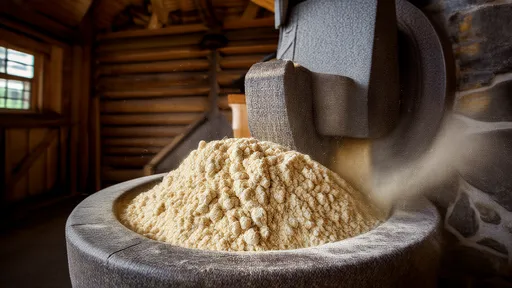The world of espresso is as complex as it is captivating, with its rich flavors and aromatic allure. At the heart of this complexity lies a seemingly simple yet scientifically intricate component: the crema. This golden-brown layer of foam that crowns a well-pulled shot of espresso is not just a visual delight but a fascinating study in colloidal stability. The interplay of oils, gases, and solids in espresso crema reveals a delicate balance that defines the quality and texture of the coffee.
Coffee crema is a colloidal system, a suspension of tiny gas bubbles in a liquid medium stabilized by emulsified oils and fine coffee solids. When hot water is forced through finely ground coffee under high pressure, it extracts not only the soluble compounds but also the insoluble oils and microscopic particles. These components, along with the dissolved carbon dioxide, form the basis of the crema. The stability of this foam depends on the ability of the oils and solids to form a protective barrier around the gas bubbles, preventing them from coalescing and collapsing.
The role of coffee oils in crema stability cannot be overstated. These oils, primarily triglycerides and diterpenes like cafestol and kahweol, are hydrophobic yet capable of forming interfacial films around gas bubbles. The pressure during extraction forces these oils into an emulsion, where they act as surfactants, reducing surface tension and stabilizing the bubble structure. However, not all oils contribute equally. Freshly roasted coffee contains a higher proportion of intact lipids, which are more effective at stabilizing crema compared to stale coffee where oxidation has degraded these compounds.
Temperature plays a crucial role in the formation and persistence of crema. The ideal extraction temperature—typically between 90°C and 96°C—ensures proper solubility of compounds while maintaining the viscosity needed to suspend the gas bubbles. Too low, and the oils won't properly emulsify; too high, and the bubbles grow too large, leading to rapid collapse. The cooling of the espresso after extraction further affects crema stability, as the changing temperature alters the viscosity of the liquid phase and the elasticity of the bubble walls.
The fineness of the coffee grind and the tamping pressure applied before extraction influence crema quality by determining the resistance to water flow. A consistent, fine grind creates uniform channels for water to pass through, promoting even extraction of oils and solids. Over-extraction, however, can lead to excessive bitterness and a weaker crema, as too many soluble compounds overwhelm the system. The duration of the shot also matters—a standard 25-30 second extraction tends to produce the most balanced crema.
Bean freshness is another critical factor in crema stability. As coffee ages, it loses carbon dioxide—the gas responsible for forming the bubbles in crema. Stale coffee produces less voluminous and less persistent foam. The roast level also affects crema characteristics. Darker roasts generally produce more visible crema due to increased CO2 development during roasting and higher oil migration to the bean surface, but this crema may be less stable than that from lighter roasts with more intact cellular structures.
Water quality impacts crema more than many realize. Hard water with high mineral content can interfere with the extraction of oils and the formation of stable emulsions. Conversely, water that's too soft may not extract enough compounds to support a robust crema. The ideal water for espresso strikes a balance—enough minerals to facilitate extraction but not so much as to disrupt the colloidal chemistry.
The serving vessel plays an often-overlooked role in crema preservation. A pre-warmed demitasse helps maintain the espresso's temperature, slowing the inevitable breakdown of the foam. The shape of the cup also matters—narrower openings reduce surface area exposure to air, slowing bubble coalescence. Some baristas even recommend avoiding stirring the crema, as this accelerates the release of gas and the collapse of the foam structure.
From a consumer perspective, crema serves as an indicator of espresso quality. A thick, persistent crema with a tiger-striped pattern suggests proper extraction and fresh beans. However, crema alone doesn't guarantee flavor excellence—it's possible to have beautiful crema with mediocre taste if other extraction parameters are off. The visual appeal of crema has become culturally significant, shaping expectations and even preparation methods, as seen in the popularity of crema-rich drinks like the flat white.
Scientific research into espresso crema continues to reveal new insights. Advanced imaging techniques have shown how bubble size distribution affects mouthfeel, while spectroscopic analysis has identified specific lipid fractions most responsible for foam stability. These findings not only satisfy academic curiosity but have practical applications for coffee professionals seeking to perfect their craft. Understanding the colloidal nature of crema allows for more intentional manipulation of variables to achieve desired results.
As espresso culture evolves globally, so does the appreciation for its physical chemistry. What was once considered mere froth is now recognized as a sophisticated system where physics, chemistry, and culinary art intersect. The pursuit of the perfect crema drives innovation in equipment, techniques, and even green coffee selection. In this light, every espresso shot becomes a miniature laboratory demonstrating principles of colloid science—principles that, when mastered, transform simple coffee into something extraordinary.
The art of baking a perfect cake relies heavily on understanding the science behind its structure. Among the many factors that contribute to a cake's texture, the uniformity of air pockets within the cake crumb stands out as a critical element. This characteristic is largely influenced by the foaming properties of proteins in the batter, particularly those found in eggs. The way proteins trap and stabilize air bubbles during mixing directly impacts the final product's lightness, tenderness, and overall mouthfeel.
The world of sensory evaluation is as intricate as it is fascinating, particularly when it comes to understanding how we perceive flavors and aromas. Among the myriad of compounds that contribute to our sensory experiences, vanillin—the primary component of vanilla extract—stands out for its widespread use and complex interaction with our senses. The concept of odor threshold plays a pivotal role in determining how much of this compound is needed for it to be detectable, and it varies significantly depending on the medium in which it is presented.
The world of chili peppers is as diverse as it is fiery, with each variety packing its own unique punch. At the heart of understanding this heat lies the Scoville Scale, a measurement that quantifies the spiciness of peppers. Developed by Wilbur Scoville in 1912, this scale remains the gold standard for gauging the capsaicin content—the compound responsible for that burning sensation—in different peppers. From the mild bell pepper to the mind-numbing Carolina Reaper, the Scoville Scale offers a fascinating glimpse into the spectrum of heat that chili enthusiasts chase.
The culinary world has long celebrated the magic that happens when certain ingredients come together, creating flavors greater than the sum of their parts. One such pairing—chicken broth and mushrooms—exemplifies the scientific and gastronomic phenomenon known as umami synergy. This dynamic duo has been a staple in kitchens across cultures, from French consommé to Japanese ramen, and its power lies in the way their compounds interact to amplify savory depth.
The world of fermented foods is a fascinating intersection of microbiology, chemistry, and culinary tradition. Among these, kimchi stands out not only for its bold flavors but also for the intricate biochemical processes that transform raw vegetables into a probiotic-rich delicacy. At the heart of this transformation lies a phenomenon known as acetic acid penetration, which creates a dynamic pH gradient during fermentation. This process is far more than a simple souring of cabbage—it's a carefully orchestrated dance between microbial communities and their chemical environment.
The turbidity of fruit juice, often perceived as a mark of freshness and natural quality, is primarily governed by the suspension mechanisms of pulp particles. These tiny fragments of fruit flesh, ranging from cellular debris to larger fibrous clusters, create the characteristic cloudiness that consumers associate with premium products. Behind this seemingly simple phenomenon lies a complex interplay of physical forces, biochemical interactions, and processing variables that determine whether pulp remains evenly dispersed or separates over time.
The fizz in your soda isn't just about taste—it's a carefully engineered dance between gas and liquid that begins unraveling the moment you twist open the cap. Few consumers realize how precisely carbonation levels are calibrated, or how dramatically pressure dynamics shift during that first explosive release. This invisible physics experiment in every bottle follows predictable but fascinating patterns that beverage scientists have spent decades mapping.
The world of espresso is as complex as it is captivating, with its rich flavors and aromatic allure. At the heart of this complexity lies a seemingly simple yet scientifically intricate component: the crema. This golden-brown layer of foam that crowns a well-pulled shot of espresso is not just a visual delight but a fascinating study in colloidal stability. The interplay of oils, gases, and solids in espresso crema reveals a delicate balance that defines the quality and texture of the coffee.
The phenomenon of "cold turbidity" or "cream down" in tea has long intrigued both tea connoisseurs and scientists alike. This natural occurrence, where tea liquor turns cloudy upon cooling, is not merely an aesthetic curiosity but a window into the complex chemistry of tea. Recent advancements in optical measurement techniques have enabled researchers to quantify this phenomenon through turbidity detection based on tea liquor transmittance, opening new avenues for quality assessment and understanding of tea's molecular interactions.
The world of instant noodles thrives on convenience, but behind that simplicity lies a carefully engineered marvel of food science. At the heart of this innovation sits pregelatinized starch—an unsung hero that transforms dehydrated noodles into a steaming bowl of comfort within minutes. Unlike traditional starch, pregelatinized starch undergoes a thermal and mechanical treatment that breaks down its granular structure, allowing it to absorb water rapidly. This property is pivotal for instant noodles, where rehydration speed and texture determine consumer satisfaction.
The world of traditional fermented foods holds countless microbial secrets, and few are as fascinating as the complex ecosystem of laomian – the centuries-old sourdough starter that gives Chinese steamed bread its distinctive character. While modern bakeries increasingly rely on commercial yeast, artisanal producers across northern China still maintain their family laomian cultures like precious heirlooms, passing down not just techniques but living microbial communities through generations.
The sticky, chewy texture of glutinous rice cakes, known as mochi in Japanese or nuòmǐ cí in Chinese, has long been a staple in East Asian cuisine. These delectable treats, often enjoyed during festivals or as everyday snacks, owe their unique consistency to a key component: amylopectin, the branched-chain starch found in glutinous rice. However, anyone who has left mochi or Chinese mochi cakes (糍粑) at room temperature for a few hours will notice an unmistakable transformation—the once-soft and pliable dessert gradually hardens, becoming tougher and less enjoyable. This phenomenon, often referred to as retrogradation, is a fascinating interplay of chemistry, physics, and culinary science.
The art of cooking perfect rice lies in understanding the gelatinization temperature of different japonica rice varieties. This scientific parameter, often overlooked by home cooks, determines the precise moment when starch granules absorb water and swell—fundamentally shaping texture, flavor release, and nutritional accessibility. Recent studies across Asian research institutions reveal how subtle genetic variations in short-grain rice cultivars create distinct thermal behaviors during cooking, challenging the one-size-fits-all approach to water ratios and heat application.
The art of crafting perfect hand-pulled noodles lies in mastering the delicate balance between gluten development and dough relaxation. Among the many variables that influence noodle extensibility, resting time stands as one of the most critical yet often overlooked factors. This silent alchemy occurring during the waiting period transforms a stiff, unyielding mass into an elastic, cooperative material ready to be stretched into silky strands.
For generations, home cooks and professional chefs alike have relied on stainless steel containers for pickling and food storage. The material's reputation for durability and corrosion resistance makes it a seemingly ideal choice. But when acidic ingredients like vinegar enter the equation, questions arise about potential metal leaching and food safety. Understanding the interaction between stainless steel and pickling brines requires a deeper dive into metallurgy, chemistry, and culinary science.
The bamboo steamer, a centuries-old culinary tool cherished across Asian kitchens, operates on principles far more sophisticated than its simple appearance suggests. Among its most fascinating phenomena is the so-called "bamboo steamer effect" – a self-regulating mechanism that prevents the dreaded condensation drip-back, ensuring perfectly textured dumplings, buns, and fish every time. This natural engineering marvel has captivated chefs and scientists alike, revealing how traditional wisdom often anticipates modern food science.
The age-old practice of stone milling has long been revered for its ability to produce flour that retains the natural goodness of whole grains. Unlike modern industrial milling methods, which often prioritize speed and shelf life, stone grinding operates at a slower pace, preserving the integrity of the grain’s nutritional profile. One of the most significant advantages of this traditional method is its ability to maintain higher levels of dietary fiber in whole wheat flour—a component essential for digestive health, blood sugar regulation, and overall well-being.
















